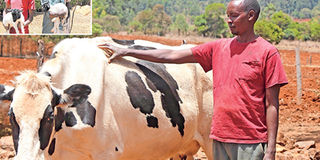I built my 13-cow farm and milk shop from single calf

Dairy farmer Erick Kiprotich in his farm in Nandi County. Kiprotich with his friends (inset) showcase the Dorper sheep that he also keeps in his farm. PHOTOS | RICHARD MAOSI | NATION MEDIA GROUP
What you need to know:
- His 13 animals are hosted in a cowshed that measures 22 metres long and six metres wide. The unit is partitioned, enabling each cow to occupy a cubicle.
- Kiprotich feeds the cows a variety of fodder, ranging from napier grass, desmodium, sweet potatoes and hay mixed with molasses.
- The farmer deworms his dairy cows after every three months and the calves every one month to boost growth.
- She notes that adoption of improved feeds such as desmodium and brachiaria grass can also be supplemented with other feeds like hay to boost production of milk.
Biribiriet village, some 20 kilometres from Eldoret, is currently a sea of maize and tea. The crops stand on huge plantations that stretch as far as the eyes can see.
It is here that Erick Kiprotich, who quit employment in 2006, farms on two acres.
“I have 13 Friesian dairy cows, eight of which I milk. Three are heifers and two are calves. I also keep Dorper sheep.”
Kiprotich began the project in 2007 with Sh10,000 from his savings, which he used to buy a calf from a livestock market in the region.
A year later, he bought two Friesian cows from a neighbour and a chaff-cutter.
“The animal helped me learn the ropes of cow management, which gave me the impetus to go big. I invested about Sh200,000 to start the dairy enterprise and adopted zero grazing,” recounts the farmer, adding he leased an acre to grow fodder.
His 13 animals are hosted in a cowshed that measures 22 metres long and six metres wide. The unit is partitioned, enabling each cow to occupy a cubicle.
“The concrete on the floor is rough, in order to prevent the animals from sliding and is washed and disinfected every day to curb diseases like foot rot,” he says, adding that he has sunk a borehole for his water needs.
Other parts of the shade include a milking parlour, feeding, watering and walking areas and a store to preserve feeds.
From his eight lactating cows, Kiprotich gets an average of 200 litres of milk each day, which he sells at Sh50 per litre at his milk shop at Biribiriet shopping centre.
“I also make mursik, a delicacy here in Nandi County, where my farm is, and sell it at Sh60 per litre.”
Kiprotich feeds the cows a variety of fodder, ranging from napier grass, desmodium, sweet potatoes and hay mixed with molasses.
“I also offer them silage made from maize and mineral salt to boost their calcium and magnesium intake,” says the farmer, who makes his own dairy meal to cut costs.
The farmer deworms his dairy cows after every three months and the calves every one month to boost growth.
COSTLY INDUSTRIAL MEALS
He uses the manure he gets from the animals to grow his napier grass, maize and sukuma wiki (collard greens).
“I also rear sheep as a hobby and currently, there are seven. I sold others last Christmas.”
He started the sheep business with two ewes and a ram and the number has been growing since then. He sells the animals for meat.
“The animals go for between Sh10,000 and Sh15,000. I sell between 10 and 12 sheep in a year,” says Kiprotich, whose wife helps him run the business and has employed two workers.
To run the shop, Kiprotich says he bought a refrigerator and acquired relevant licences.
“You cannot run the shop without a licence from the Kenya Dairy Board. They also do regular inspection to ensure there is compliance to milk safety standards. I also acquired a trading licence from Nandi County government.”
Rhoda Omariba, a pasture expert at the Kenya Agricultural and Livestock Research Organisation (Kalro), Lanet, says dairy farming is a profitable business as long as one gets feeding right.
Omariba believes it is better for farmers to form their own mechanism of feeding their livestock, such as growing forages to cut high dependency on industrial meals, which are costly.
“Dairy cows require a balanced diet to increase milk production. Feeding the cows with only grass and fodder is not enough. The cow needs a balanced diet, which must include starch, protein, fibre, minerals, water and protein in sufficient amounts,” she says.
She notes that adoption of improved feeds such as desmodium and brachiaria grass can also be supplemented with other feeds like hay to boost production of milk.
****
Get it quick
Benefits of selling your own milk
Selling milk from your own farm gives you better prices, unlike supplying to processors who buy for as low as Sh30 a litre.
Therefore, the processor ends up making more profit at the expense of farmers.
In addition, by selling your own milk, one can extract cream from the produce that they sell separately, earning more.


